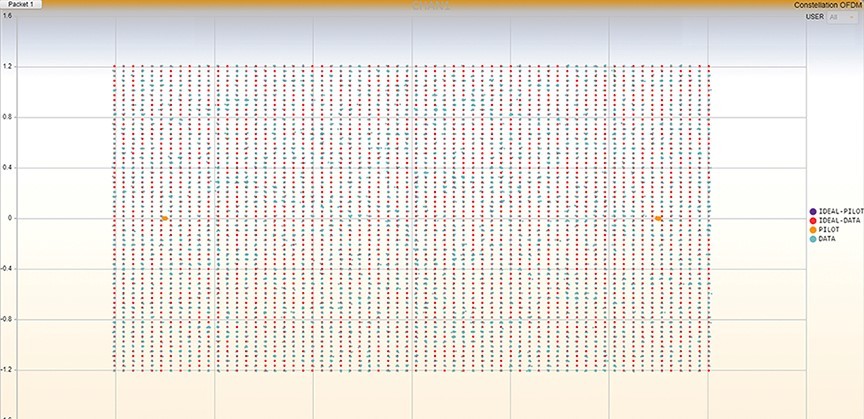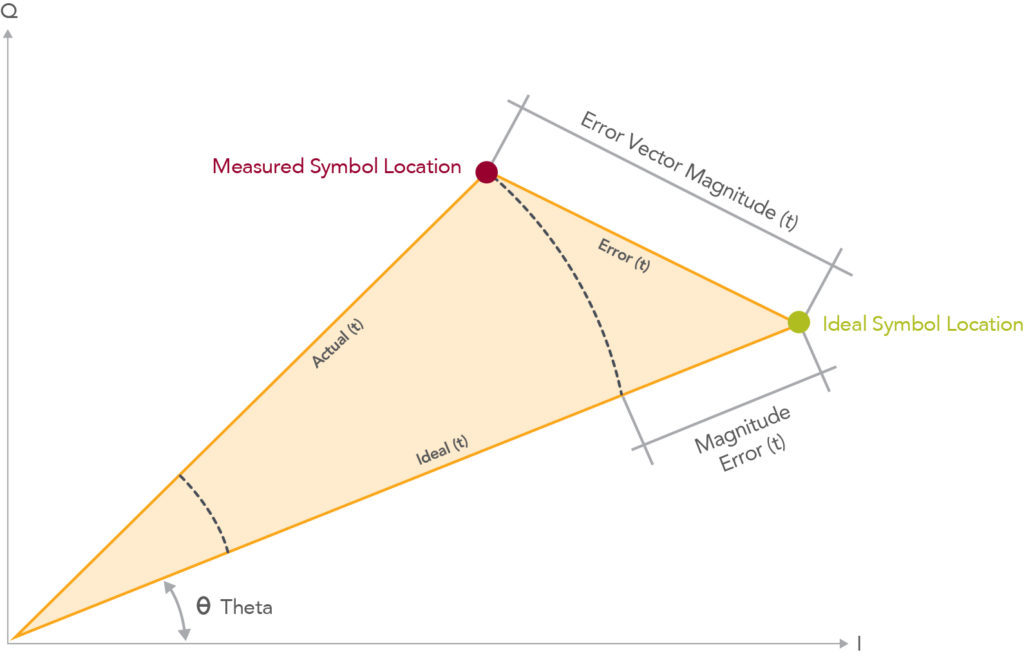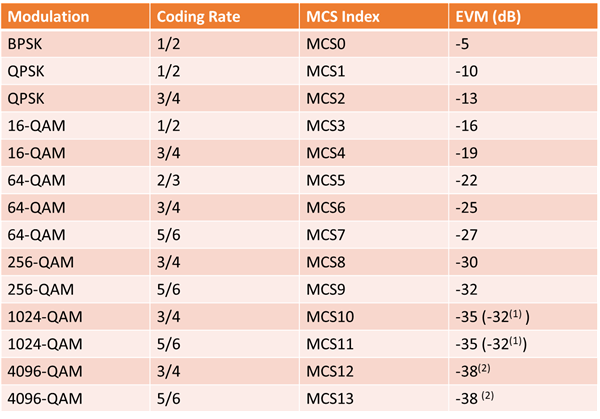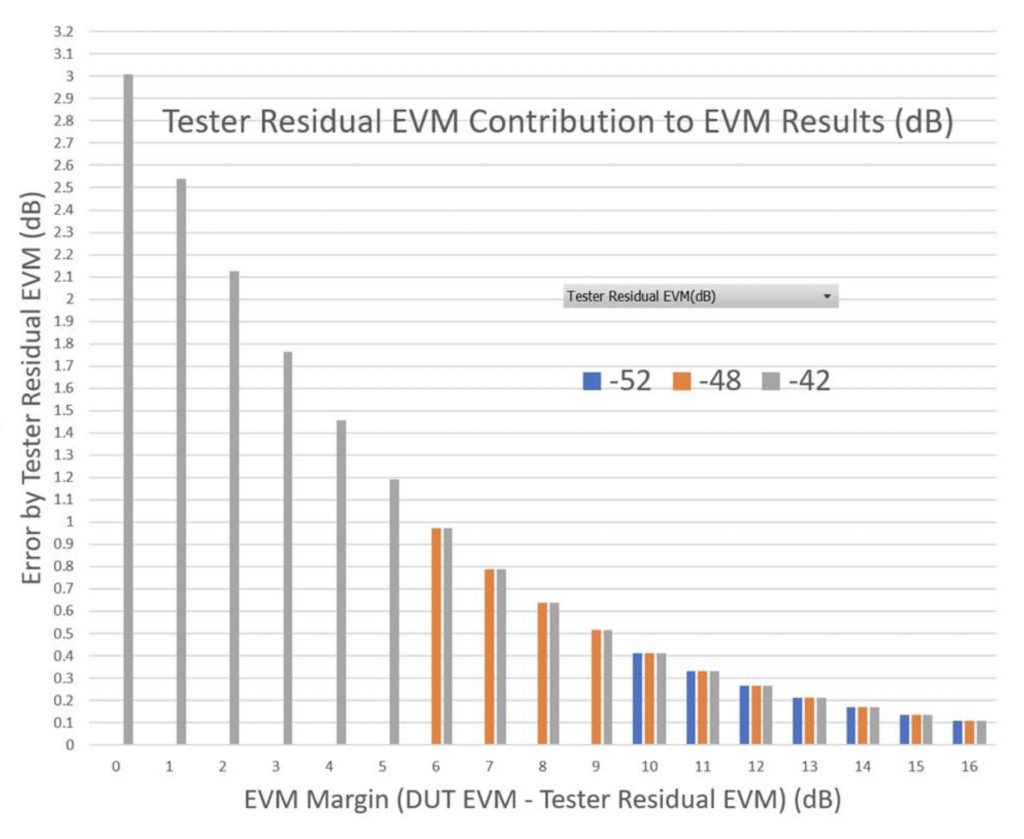EVM (Error Vector Magnitude) is the key metric used to evaluate RF transmitter performance, because it provides a consistent “yardstick” to characterize the transmitter regardless of the receiver implementation and it encapsulates a wide range of possible impairments on the transmitter chain into a single measurement. New Wi-Fi generations have increased the modulation constellation size with 1024-QAM and 4096-QAM, placing an even higher requirement into transmitter accuracy. In this blog, we will look at what EVM measures in Wi-Fi and how it is measured.
Quick Facts about QAM Constellation
With each new Wi-Fi generation, higher data rates are achieved by encoding more data bits per symbol. Higher-order QAM enables to transmit more data bits while maintaining the same spectrum footprint and therefore achieve better efficiency.
802.11ac (Wi-Fi 5) supports up to 256-QAM where 8 bits of data are encoded per symbol
802.11ax (Wi-Fi 6) supports up to 1024-QAM, where 10 bits of data are encoded per symbol
802.11be introduces 4096-QAM modulation with 12 bits of data per symbol

With a higher-order modulation, the constellation points are closer together and are therefore more susceptible to noise and non-linearities. The digital communication channel requires a better Signal-to-Noise ratio (SNR) to operate error free compared to using lower modulation rates, because the separation between constellation points is reduced and so is the decision distance in the receiver. The transmitter also needs to perform with significantly better accuracy, the Error Vector Magnitude (EVM) is the metric used to quantify the accuracy.
What is EVM?
Error Vector Magnitude is the most commonly used modulation quality metric in digital communications, it is a measure of the deviation of the actual constellation points from their ideal locations in the constellation diagram. The Root-Mean-Square (RMS) error is averaged over subcarriers, frequency segments, OFDM frames and spatial streams and measured at the symbol clock transitions. It is expressed in %Root-Mean-Square or dB.

EVM is a comprehensive measure of the transmit quality because it reflects signal defects that affect the magnitude or phase of the transmitted symbol. It captures the sum of imperfections in the device implementation that impact the transmit symbol’s accuracy. Possible impairments can arise at the baseband, IF or RF elements of the transmit chain.
Some common types of corruption are:
- I/Q gain and phase mismatch: gain mismatch originates from the two baseband modulation input signals (I and Q) having an amplitude difference at the upconverter. Phase (or Quadrature) mismatch occurs when the two modulated baseband signals are not 100% in quadrature (90°) when being up converted by the upconverter.
- Symbol clock error: originating at the encoder, the symbol clock controls the frequency and timing of the transmission of the individual symbols
- Phase noise: originating at the LO (RF or IF)
- PA compression and non-linearity: originating in the power amplifier being operated in its compression region or showing non-linearity
IEEE EVM Requirements
The IEEE defines the maximum allowed transmitter constellation error as part of the standard. The maximum allowed depends on the data rate i.e. constellation size, since higher-order constellation requires a tighter modulation accuracy.

- For 1024-QAM, the EVM requirement is ≤ -35 dB with amplitude drift compensation disabled in test equipment. If amplitude drift compensation is enabled in test equipment, the EVM requirement is ≤ -35 dB, and ≤ -32 dB with amplitude drift compensation disabled.
- For 4096-QAM, EVM requirements as defined in IEEE 802.11be Draft 0.2
How is EVM Measured?
The test is performed over at least 20 frames. For 802.11ax HE-MU PPDU and HE-TB PPDU, if the occupied RU has 26 tones, the PPDUs under test shall be at least 32 data OFDM symbols long. For occupied RUs that have more than 26 tones, the PPDUs under test shall be at least 16 data OFDM symbols long. The frames should contain random data.
For an HE-TB PPDU with an RU smaller than a 2×996-tone RU, the test shall also include transmit modulation accuracy for the unoccupied subcarriers of the PPDU.
Because Wi-Fi operates on 3 frequency bands (2.4 GHz, 5 GHz and 6 GHz) the transmitter EVM performance should be verified at all transmit power levels and frequencies where the transmitter will operate.
Test equipment used for EVM measurements should support converting the transmitted signals into a stream of complex samples at 160 MHz or more, with sufficient accuracy in terms of I/Q amplitude and phase balance, dc offsets, phase noise, and analog-to- digital quantization noise to ensure low error margin in the measurements.
EVM Correction Items
EVM shows a dependency on the analysis options in the test equipment (such as Phase Tracking, Channel Estimate, Symbol Timing Tracking, Frequency Sync, and Amplitude Tracking). Because analysis parameters can improve EVM, they should be chosen carefully. Addition of non-standard EVM correction methods can artificially improve the DUT’s EVM measurement and hide defects that would have otherwise been detected. It is recommended to only apply IEEE standard defined EVM analysis methods to ensure an objective characterization of the DUT’s transmitter performance.
The following lists the EVM measurement and correction methods:

IEEE defined EVM analysis:
- Frequency correction: Because the receiver and transmitters have separate clocks, this correction removes the frequency error of the transmitter from the receiver.
- Phase correction: Because the receiver and transmitters have separate clocks, devices must correct for clock misalignment.
- Preamble channel estimate: The channel between the tester and DUT is calculated and corrected based on Pilot tones.
IEEE optional EVM analysis:
- Amplitude Drift Compensation: The 802.11ax standard places a different target EVM whether amplitude drift compensation is enabled in the test equipment. Amplitude drift compensation, also called amplitude tracking, removes variations due to amplitude changes between symbols. When EVM is measured with the minimum IEEE required PPDU size of 16 data OFDM symbols, the effects of amplitude drift may not be noticeable. However, when longer PPDUs are used (e.g. A-MPDU), amplitude drift may have a more pronounced effect and result in degraded EVM. If amplitude drift causing defects are present, enabling amplitude tracking in the test equipment will hide these defects resulting in a better EVM measurement. While most modern DUT Wi-Fi receivers are able to compensate for amplitude drift, defects causing amplitude drift like PA thermal performance could get masked by the use of amplitude tracking. During design evaluation and troubleshooting, EVM should be measured with and without amplitude drift compensation. A large delta between the 2 measurements will indicate an underlying condition.
Non-standard EVM corrections:
- Full Packet Channel Estimate: With this correction, the channel between tester and DUT is calculated using all the data packets. When the channel model is estimated based upon the full packet, the EVM improves because the channel model more closely fits the full packet. However, within a real-world receiver application, the packets are processed in real-time, and the channel is estimated based on the header only. This correction artificially improves EVM measurement and could hide possible phase noise, analog flatness or IQ mismatch issues (bad VCO, XTAL, compression, thermal issues, power supply)
- Channel estimate equalization: This correction removes phase noise and amplitude response from the channel, it assumes flat channel response. This correction could hide possible phase noise and analog flatness issues (bad PA, matching).
Using non-standard EVM correction can artificially improve measurements and hide underlying EVM impairments, therefore care should be taken in the selection of these parameters.
Test Equipment and Error Margin
As the requirements for the transmitter modulation accuracy rise, so do the requirements of the equipment necessary to test it. The DUT transmitter’s EVM measurement requires the test equipment’s own EVM floor to perform even better in order to provide a small measurement error.
For measuring the same DUT performance, a larger margin between DUT performance and the tester’s EVM floor will result in a smaller measurement error.

As shown in the chart above:
- 16dB margin between DUT’s EVM and tester’s EVM floor results in a 0.1dB error uncertainty to the measurement
- 6dB margin between DUT’s EVM and tester’s EVM floor results in a 1dB error uncertainty to the measurement
- 0dB margin between DUT’s EVM and tester’s EVM floor results in 3dB error uncertainty to the measurement
For high order modulations 1024-QAM or 4096-QAM, that require stringent transmitter accuracy, selecting test equipment with low EVM floor is critical, otherwise the error uncertainty contributed by the test equipment reduces the confidence in the final measurement. In extreme cases, where the tester’s EVM floor equals that of the DUT, the measurement error is too large to determine if DUT meets the IEEE EVM requirements.
Key Takeaways
EVM provides a concise “one number” summary of the transmitter quality as it encapsulates a wide range of possible impairments on the transmitter chain. EVM is used during the design phase to characterize devices and uncover underlying sources of distortions. Because of its simplicity, it is also used in manufacturing to guarantee that transmitters will operate properly in real-world environments. However, it is important to understand that EVM is a calculated metric and numerous correction terms are possible that modify the measurement. The test equipment’s EVM floor is an equally important factor that affects the accuracy of the measurement. LitePoint’s IQxel family of testers provide best-in-class EVM performance to ensure high confidence in EVM measurements for the latest Wi-Fi generation.
To learn more about EVM: Read Litepoint’s Application Notes.
TestEquity are the approved UK partner for Litepoint
Content Source: EVM Error Vector Magnitude Measure in Wi-Fi | LitePoint






